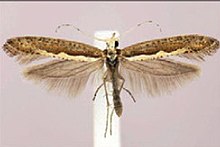| Diamondback moth | |
|---|---|

| |

| |
| Scientific classification | |
| Domain: | Eukaryota |
| Kingdom: | Animalia |
| Phylum: | Arthropoda |
| Class: | Insecta |
| Order: | Lepidoptera |
| Family: | Plutellidae |
| Genus: | Plutella |
| Species: | P. xylostella
|
| Binomial name | |
| Plutella xylostella | |
| Synonyms | |
|
List
| |
The diamondback moth (Plutella xylostella), sometimes called the cabbage moth, is a moth species of the family Plutellidae and genus Plutella. The small, grayish-brown moth sometimes has a cream-colored band that forms a diamond along its back.[1] The species may have originated in Europe, South Africa, or the Mediterranean region, but it has now spread worldwide.[2][3]
The moth has a short life cycle (14 days at 25 °C), is highly fecund, and is capable of migrating long distances.[4] Diamondback moths are considered pests as they feed on the leaves of cruciferous crops and plants that produce glucosinolates.[4] However, not all of these plants are equally useful as hosts to the moth. Because of this, studies have suggested using wintercress as a trap crop around agricultural fields because diamondback moths are highly attracted to that plant but their larvae fail to survive when eggs are laid on it.[5]
Originally, pesticides were used to kill the moths but diamondbacks have developed resistance to many of the common chemicals. For this reason, new biological and chemical controls, as well as different planting methods, are being pursued to reduce the destruction caused by the moths.[1][6]
- ^ a b Capinera, John L. "University of Florida".
- ^ AgroAtlas
- ^ Cite error: The named reference
Weiwas invoked but never defined (see the help page). - ^ a b N. S. Talekar; A. M. Shelton (1993). "Biology, ecology and management of the diamondback moth". Annual Review of Entomology. 38: 275–301. doi:10.1146/annurev.en.38.010193.001423.
- ^ F. R. Badenes-Perez; B. A. Nault; A.M. Shelton (2006). "Dynamics of diamondback moth oviposition in the presence of a highly preferred non-suitable host". Entomologia Experimentalis et Applicata. 120 (1): 23–31. Bibcode:2006EEApp.120...23B. doi:10.1111/j.1570-7458.2006.00416.x. S2CID 5985701.
- ^ Cite error: The named reference
Weewas invoked but never defined (see the help page).